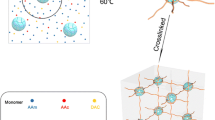Abstract
To improve the mechanical properties of responsive polymer hydrogels, a novel polymer nanocomposite hydrogel (“polymer NC gel”) consisting of a terpolymer of acrylamide (AM), acrylic acid (AA), and 2-acrylamidomethylpropane sulfonic acid (AMPS) combined with a clay was fabricated by radical polymerization. The structural, swelling, and mechanical properties of the polymer NC gel were easily controlled by varying the initiator (ammonium persulfate) loading. The polymer NC gel presented its highest swelling capacity (395.1 g/g), tensile strength (39.7 kPa), and compressive strength (6.4 MPa) when an initiator loading of 2.0 wt% was applied. Furthermore, the effects of pH and temperature on the swelling and mechanical properties of the polymer NC gel were also investigated. The swelling and mechanical properties of the polymer NC gel were found to be strongly dependent on the pH and the temperature. These important results should facilitate further improvements in the mechanical and stimuli-responsive properties of polymer NC gels.








Similar content being viewed by others
References
Abd El-Mohdy HL (2014) Radiation initiated synthesis of 2-acrylamidoglycolic acid grafted carboxymethyl cellulose as pH-sensitive hydrogel. Polym Eng Sci 54(12):2753–2761
Ahmad MG, Mohamad S, Annuar M (2014) Poly-3-hydroxyalkanoates-co-polyethylene glycol methacrylate copolymers for pH responsive and shape memory hydrogel. J Appl Polym Sci 131(23)
Killion JA, Geever LM, Cloonan M et al (2014) Synthesis and photopolymerisation of maleic polyvinyl alcohol based hydrogels for bone tissue engineering. J Polym Res 21:538
Wang YZ, Shi XN, Wang WB (2013) Synthesis, characterization, and swelling behaviors of a pH-responsive CMC-g-poly(AA-co-AMPS) superabsorbent hydrogel. Turk J Chem 37(1):149–159
Shirsath SR, Hage AP, Zhou M et al (2011) Ultrasound assisted preparation of nanoclay bentonite-FeCo nanocomposite hybrid hydrogel: a potential responsive sorbent for removal of organic pollutant from water. Desalination 281:429–437
Anirudhan TS, Sandeep S (2011) Synthesis and characterization of a novel pH-controllable composite hydrogel for anticancer drug delivery. New J Chem 35(12):2869–2876
Anirudhan TS, Mohan AM (2014) Novel pH switchable gelatin based hydrogel for the controlled delivery of the anticancer drug 5-fluorouracil. RSC Adv 4(24):12109–12118
Sun TY, Liang LJ, Wang Q et al (2014) A molecular dynamics study on pH response of protein adsorbed on peptide-modified polyvinyl alcohol hydrogel. Biomater Sci 2(3):419–426
Liu JQ, Cui L, Kong N et al (2014) RAFT controlled synthesis of graphene/polymer hydrogel with enhanced mechanical property for pH-controlled drug release. Eur Polym J 50:9–17
Zhang L, Jang S, Su E et al (2013) Biocompatible poly(ethylene oxide phosphonamidate) hydrogel for pH-sensitive doxorubicin release. J Control Release 172(1):E49–E50
Dajian H, Wang W, Yuru K et al (2012) Efficient adsorption and recovery of Pb(II) from aqueous solution by a granular pH-sensitive chitosan-based semi-IPN hydrogel. J Macromol Sci Pure 49(11):971–979
Baek Y-B, Choi S-H, Shin D-M (2014) Effect of electric fields on the hydrogel–photonic gel hybrid device. Mol Cryst Liq Cryst 600(1):9–13
Haraguchi K, Takehisa T (2002) Nanocomposite hydrogels: a unique organic–inorganic network structure with extraordinary mechanical, optical, and swelling/de-swelling properties. Adv Mater 14:1120–1124
Zhang ML, Jin F, Zheng ML et al (2014) Inverse opal hydrogel sensor for the detection of pH and mercury ions. RSC Adv 4(39):20567–20572
Songa SH, Parka JH, Chitnis G et al (2014) A wireless chemical sensor featuring iron oxide nanoparticle-embedded hydrogels. Sensors Actuators B 193:925–930
Li P, Kim NH, Hui D et al (2009) Improved mechanical and swelling behavior of the composite hydrogels prepared by ionic monomer and acid-activated Laponite. Appl Clay Sci 46:414–417
Garai A, Kuila BK, Nandi AK (2006) Montmorillonite clay nanocomposites of sulfonic acid doped thermoreversible polyaniline gel: physical and mechanical properties. Macromolecules 39:5410–5418
Peng G, Xu SM, Peng Y et al (2008) A new amphoteric superabsorbent hydrogel based on sodium starch sulfate. Bioresour Technol 99:444–447
Zhang JT, Bhat R, Jandt KD (2009) Temperature-sensitive PVA/PNIPAAm semi IPN hydrogels with enhanced responsive properties. Acta Biomater 5:488–497
Mahmoud GA (2013) Adsorption of copper(II), lead(II), and cadmium(II) ions from aqueous solution by using hydrogel with magnetic properties. Monatsh Chem 144:1097–1106
Chen J, Liu MZ, Liu HL et al (2010) Synthesis and properties of thermo- and pH-sensitive poly(diallyldimethylammonium chloride)/poly(N,N-diethylacrylamide) semi-IPN hydrogel. Chem Eng J 159:247–256
Goganian AM, Arsalani N, Khiabani HK et al (2014) Microwave promoted synthesis of smart superporous poly(dimethylaminoethyl methacrylate-co-acrylamide) hydrogels and study of Kamlet–Abboud–Taft polarity functions for obtained materials. J Polym Res 21:484
Haraguchi K, Takada T (2010) Synthesis and characteristics of nanocomposite gels prepared by in situ photopolymerization in an aqueous system. Macromolecules 43(9):4294–4299
Qiao Y, Deliwala JK, Chakravarthula SS et al (2005) High-temperature tensile properties of a polymer intercalated/exfoliated cement. Mater Lett 59(28):3616–3619
Tan Y, Xu K, Wang PX et al (2010) High mechanical strength and rapid response rate of poly(N-isopropylacrylamide) hydrogel crosslinked by starch-based nanospheres. Soft Matter 6(7):1467–1471
Bin Imran A, Seki T, Kamoka T et al (2008) Fabrication of mechanically improved hydrogels using a movable cross-linker based on vinyl modified polyrotaxane. Chem Commun 41:5227–5229
Kato K, Inoue K, Kidowaki M et al (2009) Organic–inorganic hybrid slide-ring gels: polyrotaxanes consisting of poly(dimethylsiloxane) and gamma-cyclodextrin and subsequent topological cross-linking. Macromolecules 42(18):7129–7136
Li ZK, Wang YM, Wu NM et al (2013) Removal of heavy metal ions from wastewater by a novel HEA/AMPS copolymer hydrogel: preparation, characterization, and mechanism. Environ Sci Pollut Res 20:1511–1525
Haraguchi K, Li HJ, Matsuda K et al (2005) Mechanism of forming organic/inorganic network structures during in-situ free-radical polymerization in PNIPA–clay nanocomposite hydrogels. Macromolecules 38:3482–3490
Acknowledgments
The authors are grateful for the support of the National Natural Science Foundation of China under grants 11202006 and 11202007, and the Shanxi Provincial Natural Science Foundation of China (2014021018-6).
Author information
Authors and Affiliations
Corresponding authors
Rights and permissions
About this article
Cite this article
Gao, L., Sun, Y., Zhang, W. et al. Mechanical behavior of a terpolymer-based pH- and temperature-responsive hydrogel. J Polym Res 22, 221 (2015). https://doi.org/10.1007/s10965-015-0858-4
Received:
Accepted:
Published:
DOI: https://doi.org/10.1007/s10965-015-0858-4




